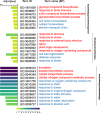Transcriptomic analysis of poco1, a mitochondrial pentatricopeptide repeat protein mutant in Arabidopsis thaliana
- PMID: 32397956
- PMCID: PMC7216612
- DOI: 10.1186/s12870-020-02418-z
Transcriptomic analysis of poco1, a mitochondrial pentatricopeptide repeat protein mutant in Arabidopsis thaliana
Abstract
Background: Flowering is a crucial stage during plant development. Plants may respond to unfavorable conditions by accelerating reproductive processes like flowering. In a recent study, we showed that PRECOCIOUS1 (POCO1) is a mitochondrial pentatricopeptide repeat (PPR) protein involved in flowering time and abscisic acid (ABA) signaling in Arabidopsis thaliana. Here, we use RNA-seq data to investigate global gene expression alteration in the poco1 mutant.
Results: RNA-seq analysis was performed during different developmental stages for wild-type and poco1 plants. The most profound differences in gene expression were found when wild-type and poco1 plants of the same developmental stage were compared. Coverage analysis confirmed the T-DNA insertion in POCO1, which was concomitant with truncated transcripts. Many biological processes were found to be enriched. Several flowering-related genes such as FLOWERING LOCUS T (FT), which may be involved in the early-flowering phenotype of poco1, were differentially regulated. Numerous ABA-associated genes, including the core components of ABA signaling such as ABA receptors, protein phosphatases, protein kinases, and ABA-responsive element (ABRE) binding proteins (AREBs)/ABRE-binding factors (ABFs) as well as important genes for stomatal function, were mostly down-regulated in poco1. Drought and oxidative stress-related genes, including ABA-induced stress genes, were differentially regulated. RNA-seq analysis also uncovered differentially regulated genes encoding various classes of transcription factors and genes involved in cellular signaling. Furthermore, the expression of stress-associated nuclear genes encoding mitochondrial proteins (NGEMPs) was found to be altered in poco1. Redox-related genes were affected, suggesting that the redox state in poco1 might be altered.
Conclusion: The identification of various enriched biological processes indicates that complex regulatory mechanisms underlie poco1 development. Differentially regulated genes associated with flowering may contribute to the early-flowering phenotype of poco1. Our data suggest the involvement of POCO1 in the early ABA signaling process. The down-regulation of many ABA-related genes suggests an association of poco1 mutation with the ABA signaling deficiency. This condition further affects the expression of many stress-related, especially drought-associated genes in poco1, consistent with the drought sensitivity of poco1. poco1 mutation also affects the expression of genes associated with the cellular regulation, redox, and mitochondrial perturbation.
Keywords: A. thaliana; ABA signaling; Flowering time; Mitochondria; POCO1; PPR protein; RNA-seq.
Conflict of interest statement
The authors declare that they have no competing interests.
Figures





References
MeSH terms
Substances
LinkOut - more resources
Full Text Sources
Molecular Biology Databases

